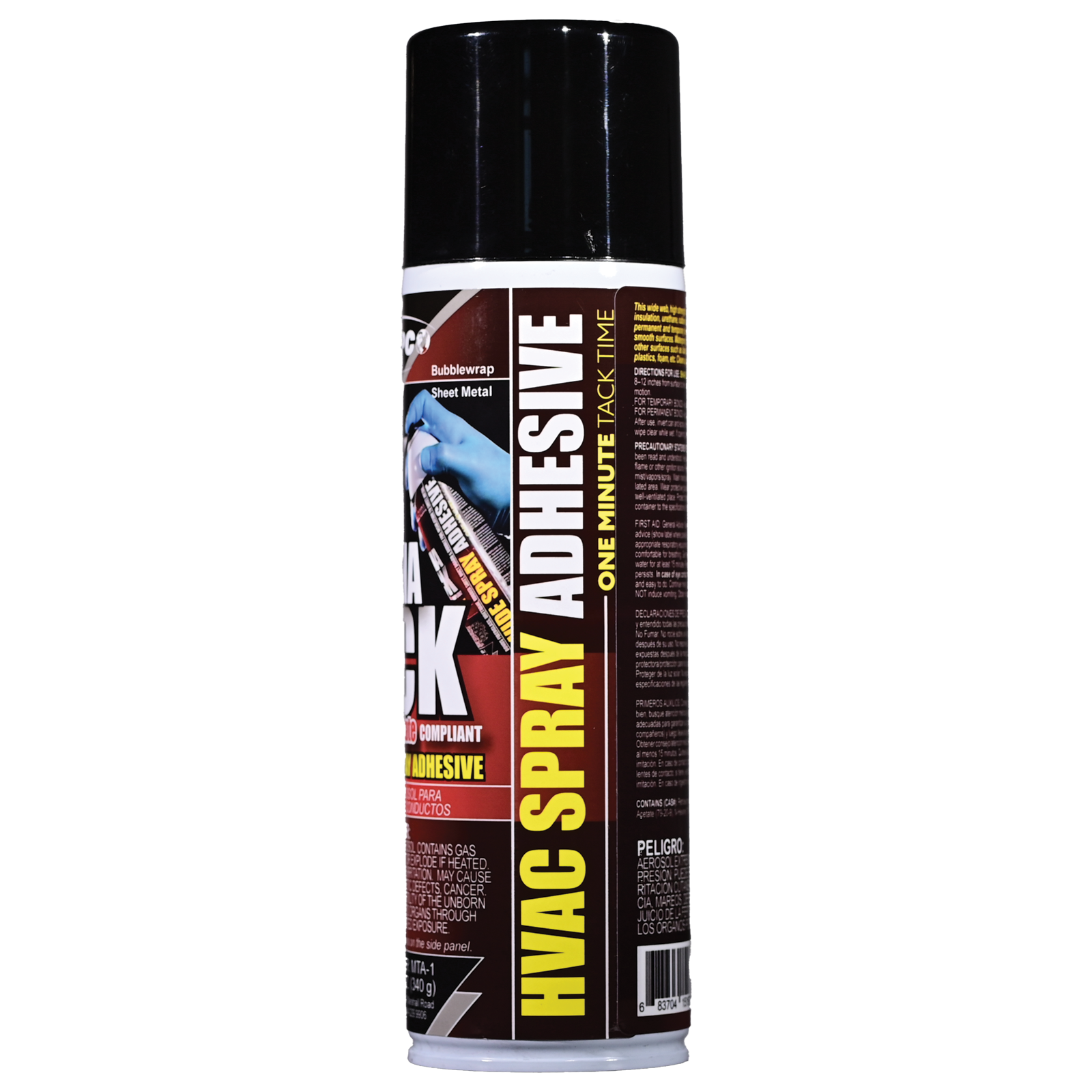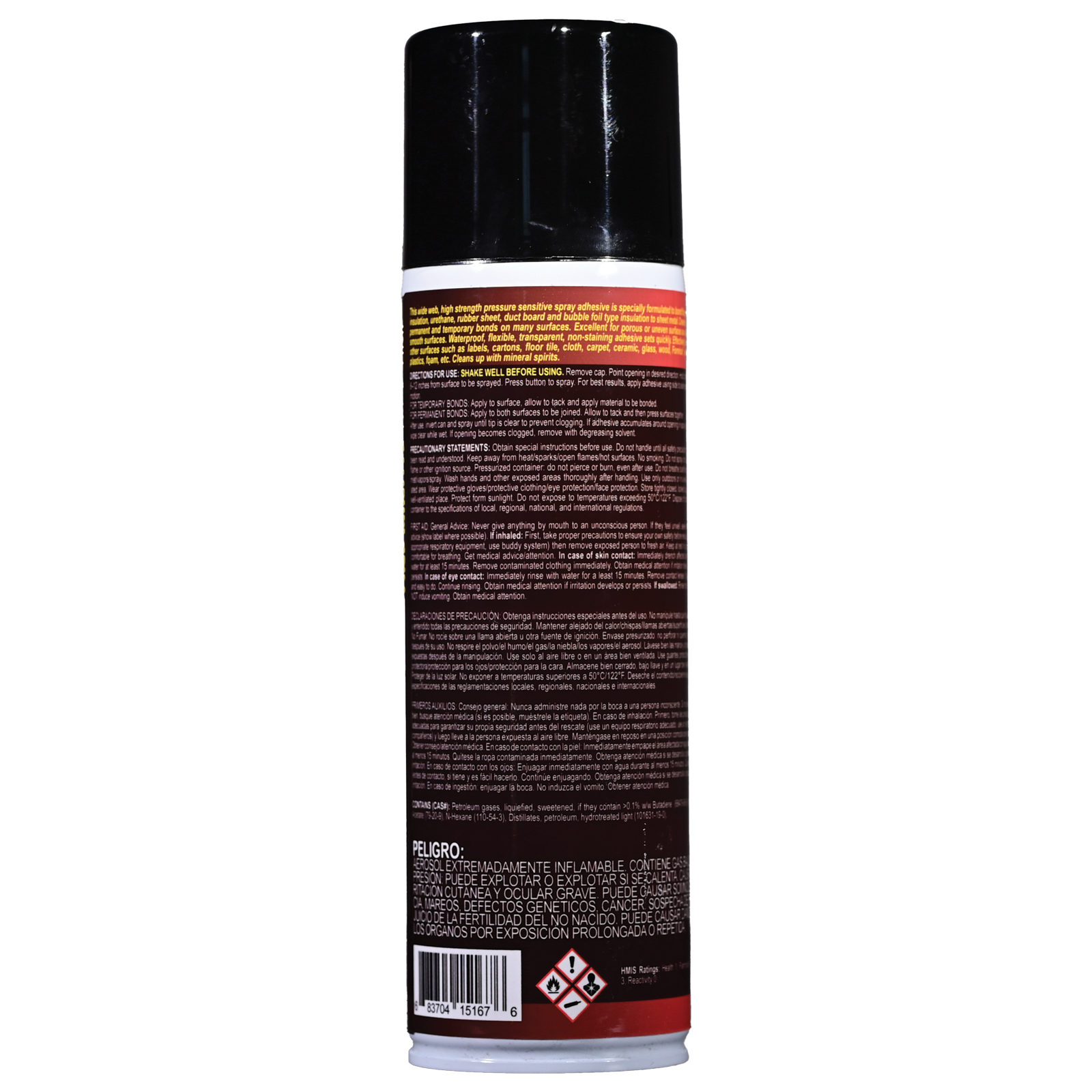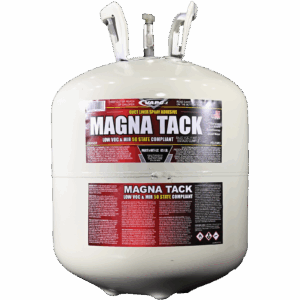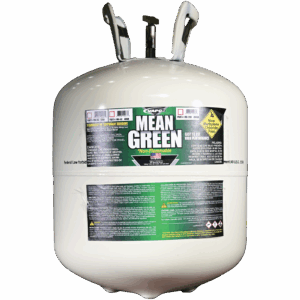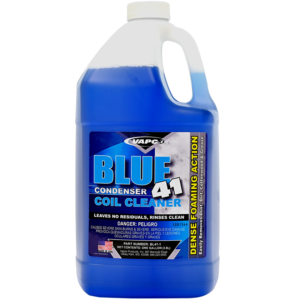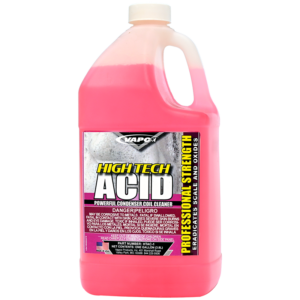Magna Tack MTA-1: 50-State Compliance, Professional Reliability
Magna Tack is not a general-purpose adhesive; it is an engineered Ultra-Low VOC, (0.9 g/L), HVAC Contact Adhesive specifically formulated to repair insulation and duct systems. Utilizing our proprietary resin technology, the adhesive delivers a high-solids (35%+) web spray for maximum yield and provides a permanent bond with superior thermal stability up to 200°F service temperature. As a result, the formula ensures immediate and long lasting, high-strength adhesion while meeting the most stringent air quality and safety codes nationwide.
| KEY FEATURE / SPECIFICATION |
TRADE BENEFIT / RESULT |
| Ultra-Low VOC (0.9 g/L) (SCAQMD 1168 Compliant) |
Project Confidence: Meets the strictest air quality codes for compliant use in schools, hospitals, and LEED-certified projects. 50-State compliant aerosol. |
| Non-Carcinogenic Solvent Base |
Reduces job-site safety liabilities; Free of restricted solvents like Methylene Chloride and Toluene. |
| Dual-Action Poly-Tack Resin Blend |
No Peel-Back: Ensures chemical adhesion to difficult low-energy plastics like bubble-wrap / bubble foil or fiberglass that generic glues fail on. |
| High Solids Content (30% – 40%) |
Superior Yield and Performance: Delivers more active glue per can, lowering cost-per-job and maximizing coverage area. Typical adhesives only use 20% solids. |
| 200°F Thermal Stability |
Reliable in Heat: Prevents bond failure and “creep” in unconditioned attic spaces or high-heat supply ducts. |
| Fast-Flash Solvent Base (1-3 min) |
Rapid Installation: Allows surfaces to be mated quickly, accelerating project completion rates. |
| Versatile Applications & Strong Bonds |
Creates permanent bonds on primary substrates: fiberglass, urethane, rubber, duct board, and bubble-wrap / bubble foil. |
| Web Spray Pattern |
Controlled Coverage: Reduces overspray and ensures the glue sits on the material surface instead of soaking in, maximizing bond strength. |
| Waterproof, Flexible, and Transparent |
Maintains bond integrity against moisture, accommodates thermal movement, and cures clear for a professional, non-staining finish. |
| Easy Cleanup |
Cleans up quickly with standard mineral spirits, reducing labor time and hassle on the job site. |
Part Number
Directions for Magna Tack Low VOC HVAC Duct Liner Spray Adhesive:
Pre-Application Checklist: Ensure both surfaces are clean, dry, and free of oil, dust, or grease. Shake the can vigorously. Maintain the optimal application temperature for the adhesive between 60°F and 90°F (15°C and 32°C).
-
Application: Hold the can 6–10 inches from the surface. Spray in a sweeping, side-to-side motion for even coverage.
-
For Permanent Contact Bonding: Apply the wide web spray evenly to both surfaces to be joined. Allow a 1–3 minute flash time for solvents to dissipate, then mate the surfaces and apply firm pressure.
-
For Temporary Bonds: Apply adhesive to one surface only and allow it to become fully tacky before applying the material.
-
Prevent Clogging: Immediately after use, invert the can and spray a few short bursts to clear the valve. Wipe away any adhesive buildup around the nozzle opening while wet.
Stop settling for low solids and low performance aerosol contact adhesives, Choose Magna Tack (MTA-1): End bond failure and slow application. Choose the Ultra-Low VOC 0.9 g/L adhesive engineered for maximum yield and proven 200°F thermal stability.
Trust Magna Tack for professional, compliant results.
EPA: Clear Air Act & Why it Matters
Contact Us
News and Updates
Subscribe on Youtube
Follow Us on Facebook
FAQs
Compliance and Safety
Q: How low is the VOC content of Magna Tack, and is it truly 50-State Compliant?
A: Magna Tack is an ultra-low VOC adhesive, containing only 0.9 g/L of Volatile Organic Compounds. This is significantly below the 80 g/L limit for contact adhesives under SCAQMD Rule 1168, ensuring full 50-State compliance for use in all commercial, residential, and green building projects (including those requiring LEED contribution).
Q: Does this adhesive contain Methylene Chloride or other restricted solvents?
A: No. Magna Tack uses a specialized Methyl Acetate/N-Hexane solvent base and is formulated to be free of ozone-depleting and carcinogenic restricted solvents, including Methylene Chloride and Toluene. This reduces job-site safety liabilities.
Performance and Adhesion
Q: Will Magna Tack bond polyethylene (PE) bubble foil insulation to metal ductwork?
A: Yes, absolutely. Magna Tack utilizes the proprietary VAPCO Dual-Action Poly-Tack Resin Blend, which is chemically engineered to bond to low-surface-energy plastics like Polyethylene and foil facings. This overcomes the major failure point of generic adhesives that struggle to stick to PE.
Q: What other primary substrates can this adhesive be used on? A: Magna Tack is engineered primarily for Fiberglass Duct Liner (1.5 lb to 3 lb density) and Galvanized Steel. It also forms strong, permanent bonds on rubber foam (K-Flex/Armaflex), urethane, duct board, and most porous and non-porous surfaces. It is also designed to grip reliably on uneven surfaces.
Q: What is the maximum service temperature the cured bond can withstand?
A: The Magna Tack bond is certified to maintain its integrity up to a service temperature of 200F. This thermal stability ensures that the adhesive will not fail, creep, or degrade in hot supply ducts, plenums, or unconditioned attic spaces.
Application and Troubleshooting
Q: How do I ensure my spray tip doesn’t get clogged after use?
A: To prevent the adhesive tip from clogging (or “sputtering”) due to dried resin, you must clear the valve and nozzle with propellant immediately after use. Wipe away any adhesive residue or buildup from around the nozzle opening while the solvent is still wet.
Q: What is the flash time needed for a permanent bond, and can I use it for temporary bonds?
A: For a permanent bond, apply an even coat to both surfaces. Allow a flash time of 1 to 3 minutes until the adhesive is tacky but does not transfer to your finger (the Knuckle Test). Then mate surfaces firmly. For a temporary or repositionable bond, apply a single, light coat to only one surface and allow it to fully dry for 5 to 10 minutes before mating.
Q: Is Magna Tack foam-safe (e.g., for Styrofoam or EPS)?
A: No. Magna Tack uses a high-strength solvent base which will dissolve low-density polystyrene and extruded polystyrene (EPS/XPS) foams. Use a foam-safe, water-based adhesive for those substrates.
Q: What is the difference between handling strength and full cure time?
A: Handling Strength (3-12 hours) is the time until the bond can withstand manipulation and light stress. Full Cure Time (24 Hours) is the time required for the adhesive to completely off-gas all residual solvents and achieve its maximum chemical resistance and full thermal stability.
Q: What makes Magna Tack a high-yield adhesive compared to alternatives?
A: Magna Tack has a verifiable high solids content of 30 percent to 40 percent by weight. This means less solvent and more active adhesive are delivered per can, resulting in a superior coverage rate and requiring fewer cans per job compared to standard 20 percent solids aerosols.
Q: What is the recommended method for cleaning up uncured adhesive?
A: Uncured Magna Tack can be cleaned up effectively using standard mineral spirits or lacquer thinner. Ensure cleanup is done while the adhesive is still wet. For preventing nozzle clogs, invert the can immediately after use and spray until the solvent runs clear.
Q: Can I use this aerosol adhesive for high-heat applications like automotive headliners?
A: While certified to 200°F for ductwork, we recommend caution for vehicle headliners. Our solvent base (Methyl Acetate/N-Hexane) is highly effective, but it may chemically attack certain vehicle-grade vinyls, thin plastics, or Styrofoam/EPS foam, which requires specialized foam-safe adhesives. For high-heat vehicle applications, we strongly recommend testing a small, inconspicuous area first, as sustained internal vehicle temperatures can sometimes exceed 200°F.
Technical Data
Field Guide: Substrate Compatibility Matrix
Magna Tack’s Dual-Action Poly-Tack Resin Blend ensures predictable performance on the demanding surfaces encountered in commercial HVAC and industrial applications.
| SUBSTRATE A (Insulation/Liner) |
SUBSTRATE B (Surface) |
BOND TYPE |
PERFORMANCE / WHY IT WORKS |
| Fiberglass Duct Liner (1.5 lb – 3 lb Density) |
Galvanized Steel / Aluminum |
Permanent |
High Solids (30-40%) web spray sits on the porous surface, preventing soak-in and maximizing cohesive strength. |
| Bubble-Wrap / Bubble-Foil |
Sheet Metal / Aluminum / Wood |
Permanent |
The Poly-Tack Resin Blend is engineered for reliable chemical weld where standard glues fail (eliminates peel-back). |
| Rubber Sheet / Urethane / K-Flex Foam |
Metal / Plastic Housings / Concrete |
Permanent |
The cured bond remains flexible, accommodating the thermal expansion and contraction of pipes and insulation without cracking or separating. |
| Duct Board / Foam Core / Cardboard |
Wood / Drywall / Paper |
Permanent / Temporary |
Suitable for permanent structural bonds (double coat) or temporary positioning (single coat). Does not bleed through paper or fabric. |
| Vinyl / Fabrics / Leather |
Vehicle Headliners / Upholstery Foam |
Permanent |
Maintains high shear strength even when fabrics are under tension, supported by 200°F thermal stability for automotive applications. |
| Polystyrene / Styrofoam (EPS/XPS) |
Any Substrate |
NOT COMPATIBLE |
WARNING: The Acetone/Heptane solvent base will chemically dissolve low-density EPS/XPS foam materials. Do NOT use. |
1. Physical & Chemical Properties
| PROPERTY |
SPECIFICATION |
| VOC Content |
0.9 g/L | 35% – 40% |
| Solids Content (by Weight) |
30% – 40% |
| Service Temperature Range |
-20°F to 200°F (-29°C to 93°C) |
| Adhesive Base / Resin System |
Synthetic Rubber / Dual-Action Poly-Tack Blend |
| Color / Appearance |
Clear to Light Amber Liquid (Web Spray Pattern) |
| Solvent Type |
Methyl Acetate Base + Blend (Non-Chlorinated) |
2. Application & Performance Metrics
| METRIC |
PERFORMANCE DATA |
| Recommended Application Temperature |
60°F to 90°F (15°C to 32°C) |
| Flash Time (Required Wait Time) |
1 to 3 Minutes (Per side, depending on humidity) |
| Open Time (Working Window) |
Up to 15 Minutes (Allows for complex alignment) |
| Est. Coverage Rate (Double-Coat) |
100 square feet per can (Based on light, controlled application) |
| Cure Time (Full Strength) |
24 Hours |
| Cleanup Solvent |
Mineral Spirits or Lacquer Thinner (While wet) |
3. Logistics & Compliance Checklist (Updated)
| ITEM |
DETAILS / CLASSIFICATION |
| California Proposition 65 |
WARNING: This product contains N-HEXANE, a chemical known to the State of California to cause male reproductive toxicity. |
| UN Number / Shipping Name |
UN1950, Aerosols, Flammable, 2.1 |
| Shipping Classification (Ground) |
ORM-D / Limited Quantity (Ltd Qty) |
| Compliance |
SCAQMD Rule 1168, LEED v4 (VOC Contribution) |
| Case Quantity / Weight |
6 Cans per Case (Net Weight specified on SDS) |
| Shelf Life |
2 Years from Manufacture Date (Stored below 100F) |
4. Estimated Structural Performance Data*
| METRIC (ASTM Type) |
LAB ESTIMATED VALUE |
| Peel Strength (180° Peel) (Aluminum to Fiberglass/Foam) |
18 – 22 PIW (Pounds per Inch Width) |
| Shear Strength (Static Load) (Aluminum to Aluminum) |
> 125 PSI (Pounds per Square Inch) |
| Adhesion Failure Mode (Typical) |
Substrate Failure (Adhesive bond exceeds strength of materials like foam or fiberglass liner) |
*Vapco has not run certified laboratory tests (e.g., ASTM) to verify these specific metrics. Performance will vary based on application technique, substrate material composition, temperature, humidity, and curing conditions.
SDS
MAGNA TACK AEROSOL SDS REV. 1
1. Identification & Supplier Details
| Product Information (Section 1.1 & 1.3) |
| Product Name / Brand: |
Magna Tack Adhesive Aerosol / Vapco |
| Product Number: |
MTA-1 |
| Recommended Use: |
50-state compliant contact adhesive aerosol |
| Supplier Details (Section 1.4 & 1.5) |
| Supplier Name: |
Vapco Products, Inc. |
| Address: |
401 Marshall Road, Valley Park, Missouri 63088, United States |
| Telephone / Email: |
(636) 923-2121 / [email protected] |
| Emergency Phone: |
(800) 255-3924 |
2. Hazard Identification & Composition
| GHS Classification (Section 2.1) |
| Signal Word: |
Danger |
| Key Classifications: |
Flammable aerosols, Cat. 1; Gases under pressure, liquefied gas; Eye damage/irritation, Cat. 2A; Toxic to reproduction, Cat. 2; Skin corrosion/irritation, Cat. 2; STOT (repeated exposure), Cat. 2; STOT (single exposure), Cat. 3. |
| Hazard Statements (H-Codes) |
| Physical Hazards: |
H222: Extremely flammable aerosol; H280: Contains gas under pressure; may explode if heated. |
| Health Hazards: |
H315: Causes skin irritation; H319: Causes serious eye irritation; H336: May cause drowsiness or dizziness; H361: Suspected of damaging fertility or the unborn child; H373: May cause damage to organs through prolonged or repeated exposure. |
| Hazardous Components (Section 3.2) |
| Component Name (CAS No.) |
Concentration (Weight %) |
| Petroleum gases, liquified, sweetened (68476-86-8) |
20 – 30 % |
| Methyl Acetate (79-20-9) |
15 – 20 % |
| Hexane (110-54-3) |
10 – 20 % |
| Distillates (petroleum), hydrotreated light (101631-19-0) |
1 – 5 % |
3. Physical & Chemical Properties
| Basic Physical Properties (Section 9) |
| Physical State / Appearance: |
Liquid / Aerosol spray |
| Color / Odor: |
Yellow/amber / Solvent odor |
| Flammability: |
Extremely flammable aerosol |
| Solubility in Water: |
Insoluble |
| Density: |
0.80 at 77°F (25°C) |
| Relative Vapor Density: |
>1 at 77°F (25°C) |
| Evaporation Rate: |
>3 Fast |
| Volatile Organic Content (VOC): |
0.9 g/L |
| Flash Point / Boiling Point / pH: |
N/D / N/D / N/A |
4. Stability & Reactivity
| Reactivity Information (Section 10) |
| Reactivity / Stability: |
None known / Chemically stable |
| Conditions to Avoid: |
Ignition sources, direct sunlight, extremely high or low temperatures, and incompatible materials. |
| Incompatible Materials: |
Some plastics, strong oxidizing agents, acids, caustics, and chemically active metals (e.g., aluminum, magnesium, sodium, potassium, and lithium). |
| Hazardous Decomposition Products: |
Oxide(s) of carbon, oxide(s) of nitrogen, and various hydrocarbons. |
5. Toxicological Information
| Acute Toxicity (Section 11) |
| Test |
Result (Component) |
| LD50 Oral (Rat) – Distillates: |
5000 mg/kg |
| LC0 Inhalation (Rat) – Distillates: |
4951 mg/m³ – 4 hrs |
| LD50 Oral (Rat) – Methyl Acetate: |
6.482 mg/kg |
| LC50 Inhalation (Rat) – Methyl Acetate: |
>49 mg/l – 4 hrs |
| Specific Health Effects |
| Eye/Skin Irritation: |
Causes serious eye irritation; causes localized defatting/drying of skin. |
| Reproductive Toxicity: |
Suspected of damaging fertility or the unborn child (H361). |
| STOT – Single Exposure: |
May cause drowsiness or dizziness (H336). |
| STOT – Repeated Exposure: |
May cause peripheral neuropathies (sensory numbness/motor weakness) due to n-hexane. |
| Other Hazards: |
Asphyxiation risk; Aspiration hazard (chemical pneumonitis if ingested). |
6. First-Aid Measures
| Emergency Procedures (Section 4) |
| Inhaled: |
Remove person to fresh air; keep comfortable for breathing. Get medical attention. |
| Skin Contact: |
Immediately drench with water for at least 15 minutes. Remove contaminated clothing. Seek medical attention if irritation persists. |
| Eye Contact: |
Rinse cautiously with water for several minutes. Remove contact lenses, continue rinsing. Seek medical attention if irritation persists. |
| Swallowed: |
Rinse mouth. **DO NOT induce vomiting.** Obtain medical attention. |
| Immediate Medical Attention: |
If exposed or concerned, get medical advice. Note: If ingested, treat chemical pneumonitis appropriately. |
7. Fire-Fighting & Accidental Release Measures
| Fire Fighting (Section 5) |
| Suitable Extinguishing Media: |
Dry chemical, foam, or carbon dioxide (CO&sub2;). |
| Specific Hazards: |
Extremely flammable aerosol. Container may explode in heat. Vapors are heavier than air and may flash back. |
| Instructions: |
Fight fire remotely due to explosion risk. Use water spray/fog for cooling exposed containers. Do NOT fight fire when fire reaches containers. |
| Protection: |
Wear NIOSH-approved SCBA with full body protective clothing. |
| Accidental Release (Section 6) |
| Personal Precautions: |
Eliminate ignition sources, ventilate area, and use appropriate PPE. |
| Containment & Cleanup: |
Contain spills with dikes or absorbents. Take up liquid spill into absorbent material. Ventilate area until gas has dispersed. |
| Environmental Precautions: |
Prevent entry to sewers and public waters. Avoid release to the environment. |
8. Handling, Storage & PPE
| Handling and Storage (Section 7) |
| Safe Handling Precautions: |
Use only outdoors or in a well-ventilated area. Do not spray on open flame or other ignition source. Do not pierce or burn pressurized container. Follow proper grounding procedures. |
| Storage Conditions: |
Store locked up. Keep away from ignition sources and incompatible materials. |
| Temperature Limit: |
Do not expose to temperatures exceeding **50°C/122°F**. |
| Personal Protective Equipment (Section 8) |
| Engineering Controls: |
Ensure adequate ventilation (explosion-proof equipment). Emergency eye wash and safety showers should be available. |
| Eye/Face Protection: |
Chemical safety goggles. |
| Skin/Body Protection: |
Protective gloves, suitable protective clothing, and fire/flame resistant/retardant clothing. |
| Respiratory Protection: |
NIOSH-approved Self-Containing Breathing Apparatus (SCBA) whenever exposure may exceed OELs. |
9. Transport & Regulatory Information
| Transport Information (Section 14) |
| UN Number: |
UN1950 |
| Class: |
2.1 |
| Proper Shipping Name: |
Aerosols, flammable, (each not exceeding 1 L capacity) |
| Packing Group (DOT/IMDG/IATA): |
N/A |
| Regulatory Information (Section 15) |
| California Proposition 65: |
WARNING: Contains **n-Hexane**, known to cause birth defects or other reproductive harm. |
| US EPA TSCA Inventory: |
All major components listed. |
| State Right To Know Components: |
Methyl Acetate (79-20-9); Hexane (110-54-3). |
10. Disposal & Ecological Information
| Disposal Considerations (Section 13) |
| Waste Classification: |
Hazardous waste according to federal regulations (U.S. EPA 40CFR 261). |
| Disposal Method: |
Dispose of contents/container to the specifications of local, regional, national, and international regulations. Do not pierce or burn. |
| Ecological Information (Section 12) |
| Persistence and Degradability: |
Readily biodegradable. |
| Bioaccumulative Potential: |
Not expected to bioaccumulate. |
| Mobility in Soil: |
Mobile in soil. |
| Environmental Note: |
Avoid release into the environment. Do not let residue come in contact with waterways. |
11. Disclaimer & Preparation Information
| Preparation Details (Section 16.2) |
| Prepared by: |
Jessica Wilson |
| Date Prepared: |
2-20-2025 |
| Disclaimer (Section 16.1) |
| To the best of our knowledge, information contained herein is accurate. However there is no assumption of liability for the accuracy or completeness of the information contained herein. Final determination of suitability of any material is the sole responsibility of the user. No warranty, expressed or inferred, regarding the product described in this SDS shall be created or inferred by any statement in this SDS. |
TDR
Technical Data Report (TDR)
Magna-Tack Low VOC HVAC Duct Liner Spray Adhesive
Product Number: MTA-1 | Supplier: Vapco Products, Inc.
1. Product Overview & Compliance
The Magna-Tack Low VOC HVAC Duct Liner Spray Adhesive is a high-performance contact adhesive specifically engineered for HVAC and industrial applications. It is designed to create permanent, high-strength bonds, primarily between fibrous insulation materials and sheet metal.
| Key Compliance Metric |
Specification |
Impact |
| Volatile Organic Compound (VOC) Content |
4 g/L (Ultra-Low) |
50-State Compliant. Suitable for LEED and Green Building projects. |
| Restricted Solvents |
None |
Free of ozone-depleting and carcinogenic restricted solvents, including Methylene Chloride and Toluene. |
2. The Competitive Advantage (Comparable Data)
Magna-Tack is formulated with advanced chemistry to provide verifiable superior performance compared to standard and older generation spray adhesives.
| Category |
Magna-Tack Performance |
Competitive Advantage |
| Product Yield |
30% – 40% Solids by Weight |
High Yield. Delivers less solvent and more active adhesive per can, resulting in a superior coverage rate. |
| Challenging Substrates |
Features the proprietary Dual-Action Poly-Tack Resin Blend. |
Chemically engineered to bond to low-surface-energy plastics (e.g., PE facings) where generic glues often fail, eliminating peel-back. |
| Thermal Stability |
Certified up to 200°F (93°C) |
Ensures the adhesive will not creep, degrade, or fail in demanding environments. |
| Solvent Profile |
Uses a specialized Methyl Acetate/N-Hexane base. |
Reduces job-site safety liabilities by eliminating restricted solvents common in legacy formulas. |
3. Key Features and Product Highlights
- Bonding Technology: Utilizes the proprietary VAPCO Dual-Action Poly-Tack Resin Blend.
- Primary Application: Ideal for Fiberglass Duct Liner (1.5 lb to 3 lb density) to Galvanized Steel and Aluminum.
- Versatility: Forms strong, permanent bonds on rubber foam (K-Flex/Armaflex), urethane, duct board, and most porous and non-porous surfaces.
- Flexibility: The cured bond remains flexible, accommodating the thermal expansion and contraction of materials.
4. Technical Specifications
4.1 Physical & Chemical Properties
| Property |
Specification |
| VOC Content (Weight) |
4 g/L (Ultra-Low) |
| Solids Content (by Weight) |
30% – 40% |
| Service Temperature Range |
-20°F (-29°C) to 200°F (93°C) |
| Adhesive Base / Resin System |
Synthetic Rubber / Dual-Action Poly-Tack Blend |
| Color / Appearance |
Clear to Light Amber Liquid (Web Spray Pattern) |
| Solvent Type |
Methyl Acetate Base + Blend (Non-Chlorinated) |
| Density |
0.80 at 77°F (25°C) |
| Flammability |
Extremely flammable aerosol |
5. Application Instructions & Guidelines
5.1 Recommended Procedure
- Preparation: Ensure surfaces are clean, dry, and free of oil or dirt.
- Application Temperature: Apply between 60°F (15°C) and 90°F (32°C).
- Permanent Bond: Apply an even coat to both surfaces.
- Flash Time: Allow 1 to 3 minutes until tacky (passes the “Knuckle Test”).
- Mating: Mate surfaces firmly under pressure.
- Temporary/Repositionable Bond: Apply a single, light coat to only one surface. Allow to fully dry for 5 to 10 minutes before mating.
5.2 Cure Times
- Handling Strength: 3–12 hours.
- Full Cure Time: 24 Hours (required to achieve maximum performance).
5.3 Clean-Up and Maintenance
- Clog Prevention: Immediately after use, invert the can and spray until the solvent runs clear.
- Uncured Adhesive: Can be cleaned up using standard mineral spirits or lacquer thinner while still wet.
Compatibility Warning: DO NOT USE on low-density polystyrene or extruded polystyrene (EPS/XPS) foams (e.g., Styrofoam). The high-strength solvent base will dissolve these materials.
6. Performance & Substrate Compatibility
Magna-Tack is engineered for predictable, permanent bonds on a wide range of surfaces.
| Substrate A (Insulation/Liner) |
Substrate B (Surface) |
Bond Type |
Performance Note |
| Fiberglass Duct Liner |
Galvanized Steel / Aluminum |
Permanent |
High solids content prevents soak-in, maximizing cohesive strength. |
| Polyethylene Bubble-Wrap / Foil |
Sheet Metal / Aluminum / Wood |
Permanent |
Poly-Tack Resin Blend creates a reliable chemical weld on low-surface-energy plastics. |
| Rubber Sheet / Urethane / K-Flex Foam |
Metal / Plastic Housings / Concrete |
Permanent |
Cured bond remains flexible, accommodating thermal movement. |
| Adhesion Failure Mode (Typical) |
Substrate Failure |
The adhesive bond strength consistently exceeds the strength of the material being bonded (e.g., fiberglass). |
7. Safety, Handling, and Regulatory Information (SDS Summary)
Important: This section is a summary. Refer to the full Safety Data Sheet (SDS) (Product No. MTA-1) for complete hazard, handling, and first-aid information.
7.1 Hazard Identification (GHS Classification)
Signal Word: DANGER
| Hazard Category |
Description |
| Physical Hazards |
H222: Extremely flammable aerosol. H280: Contains gas under pressure; may explode if heated. |
| Health Hazards |
H319: Causes serious eye irritation. H336: May cause drowsiness or dizziness. Suspected of damaging fertility or the unborn child. |
7.2 Hazardous Components
| Component Name (CAS No.) |
Concentration (Weight %) |
| Petroleum gases, liquified, sweetened (68476-86-8) |
20 – 30 % |
| Methyl Acetate (79-20-9) |
15 – 20 % |
| Hexane (110-54-3) |
10 – 20 % |
7.3 Emergency Contact
For medical or chemical emergencies, contact the 24-hour emergency line:
(800) 255-3924
White Paper
Achieving 50-State Compliance and 200°F Reliability: The New Standard for HVAC Duct Liner Adhesives
1. Executive Summary: Compliance & Performance Without Compromise
The HVAC industry is often forced to choose between strict VOC compliance and high-demand thermal performance. Magna-Tack Low VOC Adhesive eliminates this trade-off. Utilizing proprietary, advanced chemistry, it delivers guaranteed 200°F (93°C) thermal stability and superior adhesion while maintaining 50-State compliance (4 g/L VOC).
This white paper details how this adhesive addresses the three biggest pain points for modern HVAC contractors: regulatory risk, high-heat failure, and unreliable bonds on complex new insulation materials.
2. Introduction: The Changing Landscape of HVAC Adhesion
Modern HVAC contractors face unprecedented challenges driven by environmental regulations and evolving material science. Adhesives that worked reliably a decade ago now pose significant business risks:
- The Regulatory Problem: Using an adhesive above the 80 g/L VOC threshold exposes contractors to potential fines.
- The Material Problem: Modern duct liner often uses Polyethylene (PE) or foil facings, which standard adhesives fail to grip, leading to call-backs.
- The Safety Problem: Older adhesives rely on highly toxic solvents like Methylene Chloride or Toluene, increasing liability.
3. The Technical Deficiencies of Traditional Adhesives
Compliance vs. Performance
Generic, low-VOC aerosols often result in **poor coverage yield** and a weak bond that suffers **creep** (slow separation) when duct temperatures exceed 150°F (66°C), leading to insulation collapse.
The PE Surface Challenge
Standard synthetic rubber formulations fail to achieve a true **chemical weld** on **low-surface-energy** materials like PE and foil facings, resulting in a weak, mechanical bond that fails easily.
4. The Magna-Tack Solution: Engineered for Modern Compliance
The Chemistry of Compliance
Magna-Tack achieves an **ultra-low VOC content of 4 g/L** using a non-chlorinated solvent base of **Methyl Acetate/N-Hexane**. This ensures immediate, risk-free compliance on any job site.
The Dual-Action Resin Advantage
The proprietary **VAPCO Dual-Action Poly-Tack Resin Blend** is chemically engineered to form a permanent bond on low-surface-energy materials, ensuring the insulation facing is securely locked to the metal substrate.
Reliable Thermal Integrity
The resin system is certified to maintain bond integrity from **-20°F (-29°C) up to 200°F (93°C)**. This stability ensures insulation will not sag or detach in high-heat attic or supply duct applications.
5. Proof Points and Contractor ROI
Switching to Magna-Tack is a measurable business decision that improves profitability and reduces risk.
| Contractor Problem |
Magna-Tack Specification |
Value & Return on Investment (ROI) |
| Non-Compliance & Fines |
4 g/L VOC (50-State Compliant) |
Risk Elimination. Zero risk of regulatory fines or job site shutdown. |
| Material Wastage/Cost |
30%–40% Solids Content (High Yield) |
Cost Reduction. Superior coverage yield means fewer cans per job. |
| Adhesive Failure/Call-Backs |
200°F (93°C) Stability |
Liability Reduction. Eliminates adhesive failure, protecting reputation and saving re-work costs. |
| Unreliable PE Bonding |
Dual-Action Poly-Tack Resin Blend |
Performance Guarantee. Ensures a permanent bond on Polyethylene and foil facings. |
6. Conclusion and Call to Action
The era of choosing between compliance and performance is over. The Magna-Tack Low VOC HVAC Duct Liner Spray Adhesive delivers a high-yield, low-liability solution that meets the highest regulatory standards while surpassing the thermal and adhesion demands of modern materials.
Take the next step toward guaranteed compliance and reliability.
Contact us today for a job-site sample or to download the full Technical Data Report (TDR).
Comparable Products
Competitive Cross-Reference: Low VOC Aerosol Adhesives
The Vapco Advantage: Magna Tack (MTA-1) 0.9 g/L VOC, -20°F to 200°F effective temp range, and higher than most solids count 35%+ makes it a true standout for compliant HVAC contact adhesive.
| COMPANY NAME |
PRODUCT NAME |
PART NUMBER(S) |
| Vapco |
Magna Tack (Low VOC HVAC Adhesive) |
MTA-1 |
| 3M |
Hi-Strength Spray Adhesive |
90-VOC40DSC |
| Hardcast (Carlisle) |
Travel-Tack Spray Can |
308599 |
| Nu-Calgon |
Spray-n-Bond LV |
4369-85 / 4369-75 |
| DiversiTech |
Sure Stick |
315-20 |
| Rectorseal |
*No Direct Aerosol Adhesive Match Found |
N/A |
| ACE |
Spray Adhesive (General Purpose) |
SPA |
| Refrigeration Technologies |
*No Aerosol Adhesive Product Line Found |
N/A |


